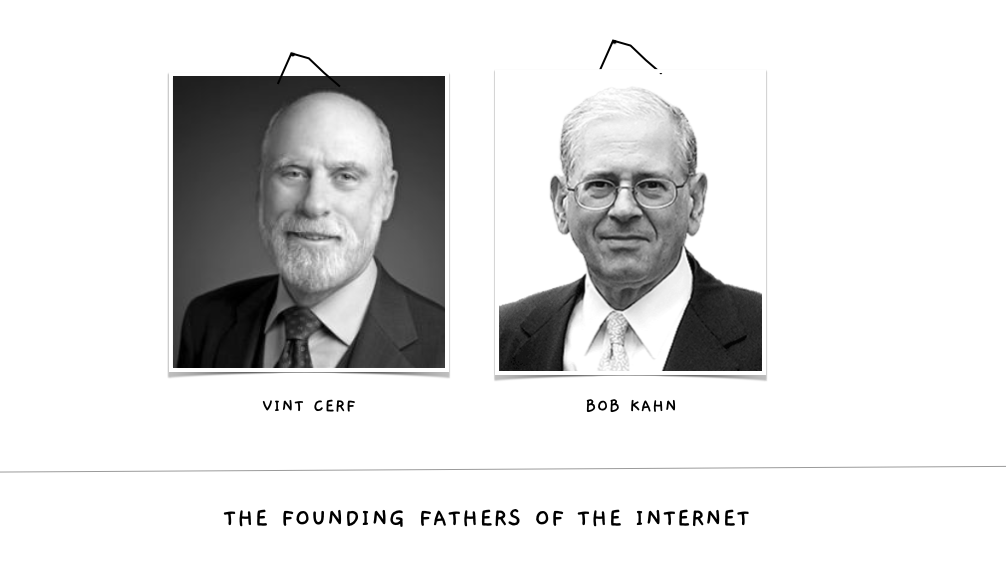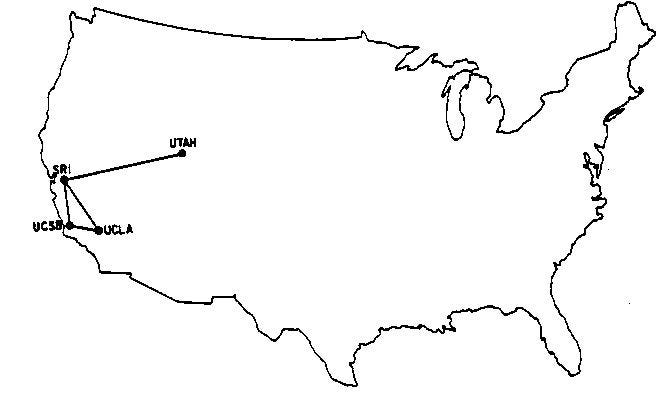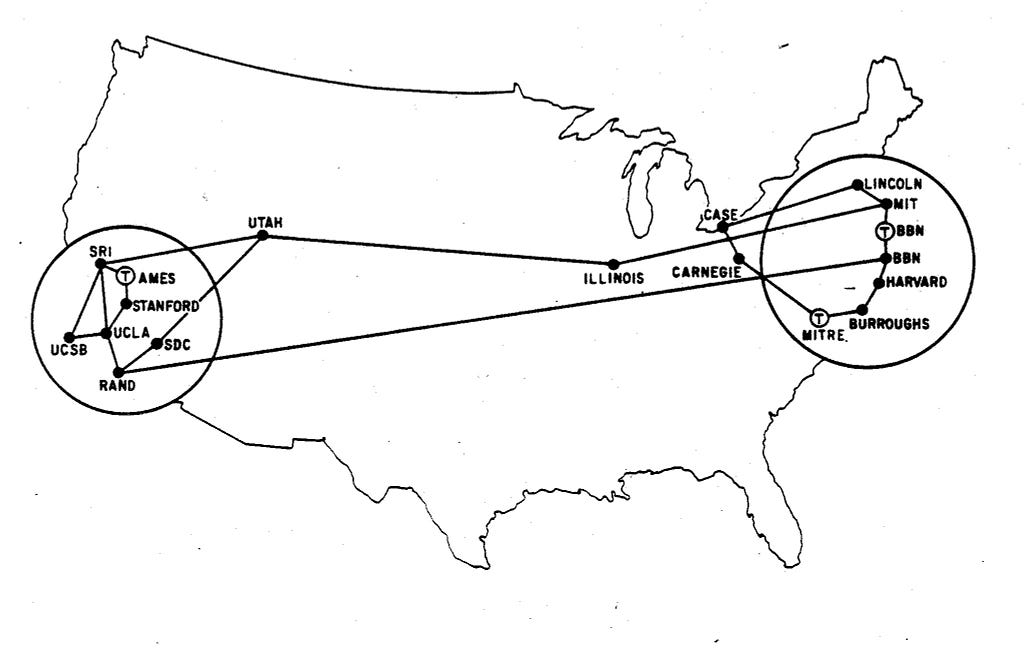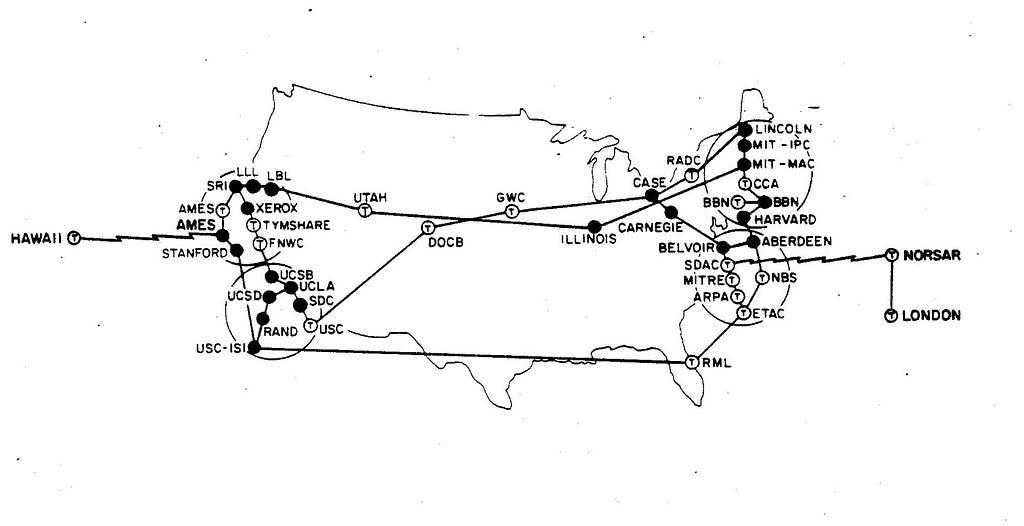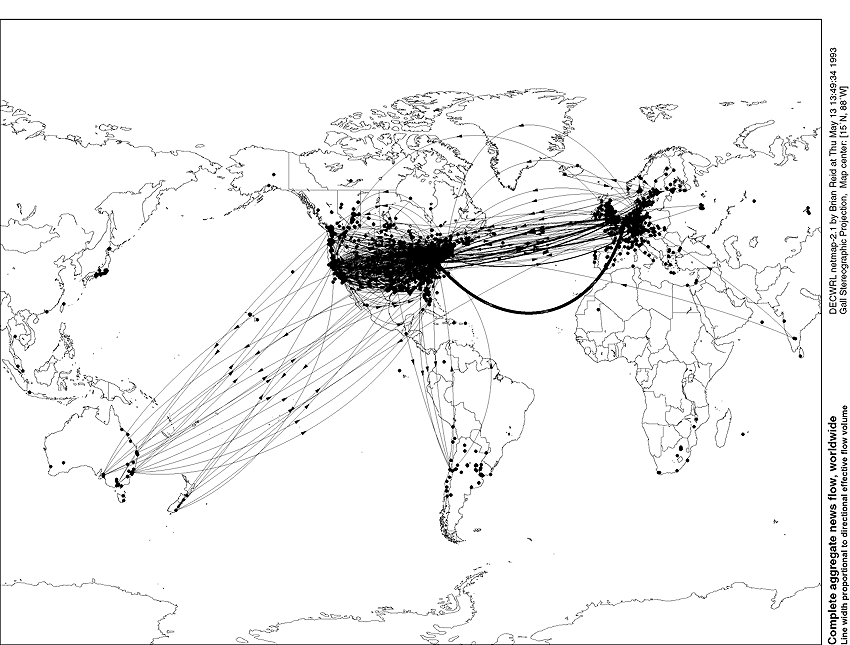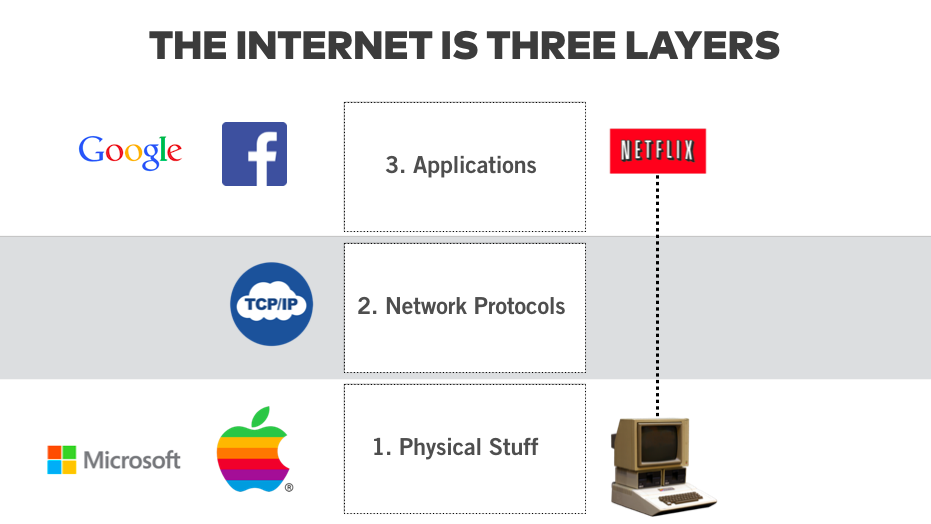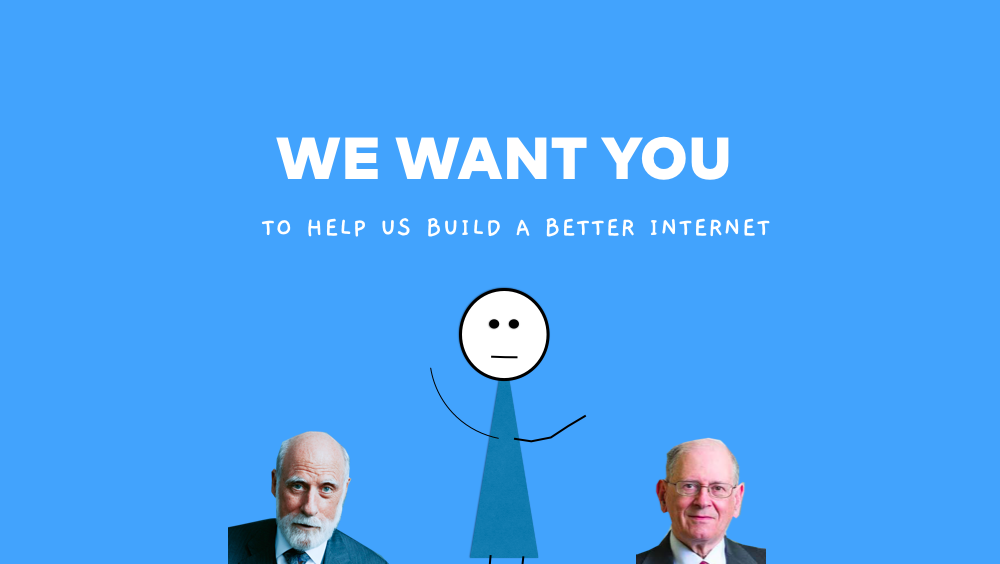Latest news about Bitcoin and all cryptocurrencies. Your daily crypto news habit.
In the autumn of 1969, a small group of people launched the most disruptive revolution of our time — and yet their names aren’t taught in high school history books, nor do we take off work to celebrate their birthdays. In this piece, I’d like to take a look at two questions: Who invented the internet? And what exactly they did they do?
On October 29th, 1969 the first message on the early internet was sent from UCLA to Stanford University: it was just two letters “lo.”
 The first message sent on the internet — On October 29th, 1969 Charlie Kline sent the internet’s first message “lo.” He had attempted to write the word “login,” but the system crashed before he could type the “g.”
The first message sent on the internet — On October 29th, 1969 Charlie Kline sent the internet’s first message “lo.” He had attempted to write the word “login,” but the system crashed before he could type the “g.”
So how did we get from “lo” to “LOL’s,” cat GIFS, YouTube, Facebook and a global internet that connects over 3 billion people around the world?
I’m about to share a sweeping history of the two people who founded the internet, the Founding Fathers if you will: Vint Cerf and Bob Kahn.
While working at the U.S. agency ARPA, they helped send the first message on the ARPANET, and a few years later they set out to accomplish one of the biggest and most audacious of goals: to create a global decentralized internet.
Please note that: Over decades, thousands, if not tens to hundreds of thousands of people, have contributed their expertise to the construction and evolution of the internet.
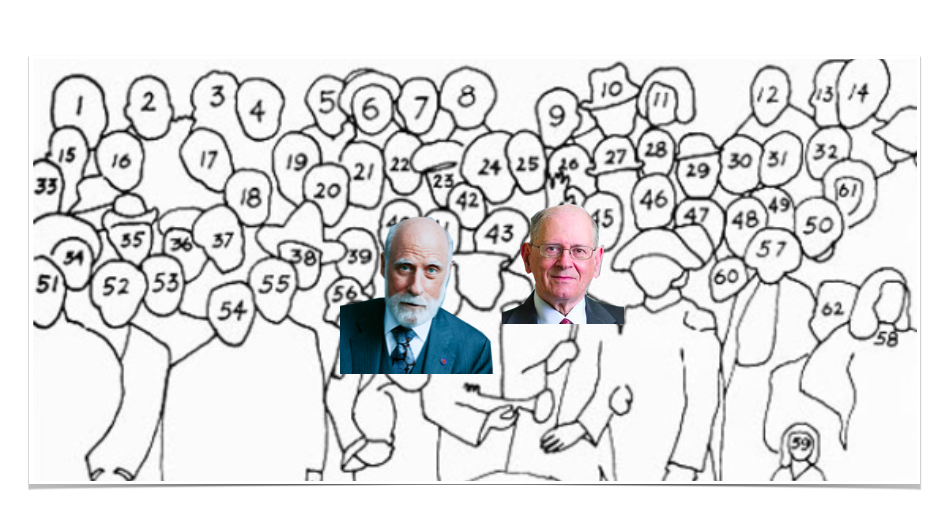 The pioneers of the early internet: 1. J.C.R. Licklider — 2. Paul Baran — 3. Vannevar Bush — 4. Bob Taylor — 5. Larry Robers, 6. Leonard Kleinrock, 7. Douglas Engelbart — 8. Claude Shannon — 9. Donald Davies — 10. Charles M. Herzfeld — 11. Louis Pouzin — 12. Glenda Schroeder — 13. Peter Kirstein — 14. Steve Crocker — 15. Jon Postel — 16. Joyce K. Reynolds — 17. Danny Cohen — 18 . NAME — 19. Ted Nelson — 20. Tim Berners Lee —21. Stewart Brand — 22. Richard Stallman — 23. Steve Wozniak […] etc.
The pioneers of the early internet: 1. J.C.R. Licklider — 2. Paul Baran — 3. Vannevar Bush — 4. Bob Taylor — 5. Larry Robers, 6. Leonard Kleinrock, 7. Douglas Engelbart — 8. Claude Shannon — 9. Donald Davies — 10. Charles M. Herzfeld — 11. Louis Pouzin — 12. Glenda Schroeder — 13. Peter Kirstein — 14. Steve Crocker — 15. Jon Postel — 16. Joyce K. Reynolds — 17. Danny Cohen — 18 . NAME — 19. Ted Nelson — 20. Tim Berners Lee —21. Stewart Brand — 22. Richard Stallman — 23. Steve Wozniak […] etc.
With that said, I’d like to focus, though, on one year in particular, 1973 — the year when the early internet, known as the ARPANET, made the leap from being a U.S. government military communications tool to a global free internet. And the two people who are responsible: Vint Cerf and Bob Kahn.
Let’s start back in 1969:
In 1969, there were only four computers (aka nodes) connected on the internet:
By 1971, we were up to 18 computers! Most of these computers were located at academic institutions like Stanford, UCLA, MIT, and Harvard.
And just two years later the network doubled in size: 40 computers!
Q: Do you notice anything missing from all of these maps?
A: How about the rest of the world?
Vint Cerf and Bob Kahn shared a vision of a global decentralized internet.
They shared the belief that “information should be free” for all humans, and that access to the internet would “make the world a better place.” For them, it wasn’t enough to create an American owned and controlled internet. They believed everyone on the planet should benefit from this technology.
Knock Knock — who’s there?
It’s Canada, France, and England who are each busy building their own national networks. And they’re not very interested in joining America’s internet.
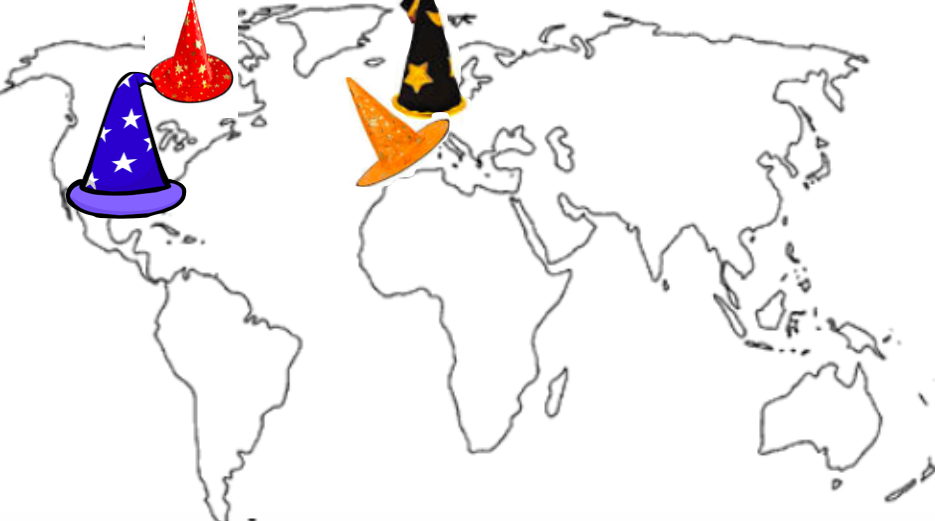 Here you see the national networks represented by wizard hats.
Here you see the national networks represented by wizard hats.
At the time the international community was using the telephone system as it’s model for building this new network — aka each country would have it’s own national “internet.”
Cerf and Kahn imagined the future differently.
They feared that using the telephone system model would also mean that there would be international taxes and data transmission fees applied to data. Or worse, clunky adapters that you’d need for an American computer to speak with a European computer.
 Imagine having to use an adaptor every time you wanted to visit an international website.
Imagine having to use an adaptor every time you wanted to visit an international website.
Think about how the national electricity grid works — and now imagine a world with roughly 195 national internets, 195 email providers, and 195 Facebook’s, etc?!
So how do you convince England, France, and Canada to join you in one global system?
The solution: create a better internet and then give it away for free. And that’s just what Vint Cerf and Bob Kahn did.
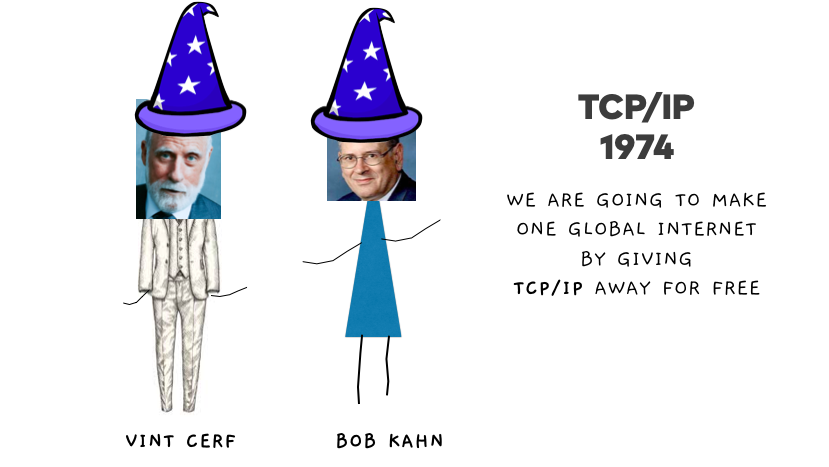 Vint Cerf and Bob Kahn invented the TCP/IP protocol. Vint Cerf is almost always wearing a suit in real life, and so I gave him a suit. Bob Kahn isn’t wearing a dress, that’s just how I draw stick figures.
Vint Cerf and Bob Kahn invented the TCP/IP protocol. Vint Cerf is almost always wearing a suit in real life, and so I gave him a suit. Bob Kahn isn’t wearing a dress, that’s just how I draw stick figures.
In 1973, Vint Cerf and Bob Kahn invented the TCP/IP protocol. TCP/IP is the magic that connects the entire world together on one network. Here Vint Cerf explains their thinking at the time,
“When Bob Kahn and I did the original designs we handed them out freely with no constraints, no patents, no other intellectual property claims for a very good reason. We wanted this to be accepted with no barriers to adoption.”
And adopted it was!
By 1993, the internet had truly become a global network.
50 years later, with over 3 billion users, TCP/IP is still being used as the backbone of the internet. So what exactly did Cerf and Kahn build? What is TCP/IP?
TCP/IP is the internet’s language
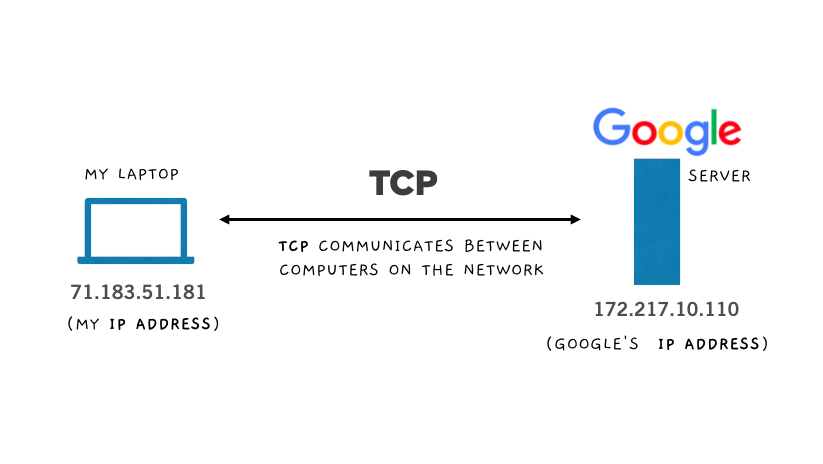 The internet is a series of wires that connect your computer to other computers. Here you see TCP (the main language of the internet) that transfers data back and forth between IP addresses.
The internet is a series of wires that connect your computer to other computers. Here you see TCP (the main language of the internet) that transfers data back and forth between IP addresses.
TCP — Transport Communication Protocol
TCP is the standard set of codes that allow computers on the internet to speak with one another. You can just think of it as the internet’s mother tongue.
Further, TCP doesn’t care what kind of data you send, and has no idea what packets of data it is carrying. In that way, TCP is, by design, neutral.
IP — Internet Protocol
IP connects your data to the internet’s address system.
Your IP address locates your computer on the internet network.
- Every personal computer on the internet is assigned an IP address (you can find your public IP address here).
- Every website (aka. the server where a websites lives) also has an IP address. For example, if you type in the IP address 216.58.216.164 your browser will go to www.google.com.
Today, when computer scientists speak about the internet, they often refer to it in terms of “layers.” TCP/IP is the middle layer of the tech stack between your computer and a website. You can’t actually see TCP/IP, just as you can’t see electricity as it powers your home. But it’s there, transporting packets of data from your computer, to Netflix (for example) and back.
Is TCP/IP broken?
Over the years there have been updates and improvements to TCP/IP, but the underlying technology has remained the same for nearly 50 years.
TCP/IP works, but it’s far from perfect.
In a recent talk at Google, Vint Cerf outlined some of the problems with TCP/IP such as it’s inability to properly handle issues of 1) security (viruses, data hacking attacks, phishing, etc.), and 2) identity (authenticating and distinguishing good users and servers, from malicious ones).
Cerf on the future of TCP/IP said,
“One of the things I want to emphasize to you is that I am NOT an IP bigot. I’m not a TCP bigot. Just because I’ve been involved in designing and building that stuff does not mean that it is the place to stop. […] The important thing is that none of you should be afraid to say maybe we should do something different.”
Over the past few years people have been doing “something different”:
As an example, forget everything you know about Bitcoin — Bitcoin, technically, is a protocol designed specifically to improve the security and identity of money transfer on the internet’s network layer. Thus, making up for vulnerabilities and a lacking in the TCP/IP protocol.
If you’ve been following HBO’s Silicon Valley, you’ll be familiar with the fictional company Pied Piper planning to build “a new internet.” Well not only is Pied Piper’s plan possible, it’s already happening. Organizations like Blockstack, The Ethereum Foundation, Consensys and Filecoin, are the real-life Pied Pipers working hard to improve data flow on the internet.
There’s a lot of innovation coming.
Final Thoughts
The internet has brought immeasurable benefits to humanity. As we approach the 50th anniversary of the internet on October 29th, 2019, it’s important that we celebrate the past from which we came. Moving forward, I believe it’s important that we educate ourselves on how these tools work so that more people can be involved in building the future of the internet.
Much like building a cathedral, the internet has taken many years, and each decade new people have come along and laid down a new block on top of the old foundation. Cerf and Kahn may have invented the primary protocol for today’s internet. But the future of the network is coming, and there’s a lot of work to be done.
The movement needs skilled developers to build tools, it needs educated politicians in Washington D.C. who are able to regulate wisely, it needs entrepreneurs and businesses able to support its economic growth, and it needs an educated public (like me and you) able to understand, adapt, and evolve alongside the future of our global network.
Want more? Enjoy my two other pieces in this series: On Decentralization, and the The Secret Hacker Ethic.
Sign up for early access to the next chapter in The History of the Internet.
Who invented the internet? was originally published in Hacker Noon on Medium, where people are continuing the conversation by highlighting and responding to this story.
Disclaimer
The views and opinions expressed in this article are solely those of the authors and do not reflect the views of Bitcoin Insider. Every investment and trading move involves risk - this is especially true for cryptocurrencies given their volatility. We strongly advise our readers to conduct their own research when making a decision.
